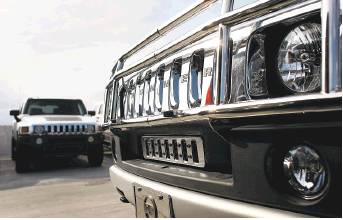Families are pairing gas sippers, guzzlers like diet soda, fries
By Peter Fimrite and Michael Cabanatuan
Human nature, as defined by those of us who use our morning runs to justify pigging out on jelly doughnuts, has a tendency to torpedo even high-minded goals — including, it turns out, fuel efficiency.
A study released Tuesday by economists at UC Davis shows that families who own fuel-efficient cars tend to buy big, powerful gas guzzlers as their second vehicle, largely defeating the purpose of the little petrol sippers in their garages.
The researchers, who studied California Department of Motor Vehicle trends for two-car households over several years, likened the phenomena to the “diet soda effect,” in which people who buy diet drinks reward themselves by wolfing down greasy french fries.
“If people buy a more fuel-efficient car, down the road when they replace one of their cars, the car they buy is going to be less fuel-efficient,” said lead author David Rapson, an associate professor of economics at the UC Davis Department of Economics and co-director of the Davis Energy Economics Program. “So the effect of fuel economy standards is reduced.”
Not only that, Rapson said, but because of the fuel-cost savings, the owners of the fuel-efficient cars tend to drive them more, which ultimately leads to more gasoline being burned, thereby counteracting the decision not to drive the hulking sport utility vehicle.
These tendencies reduce by up to 60 percent the expected future gas savings from increased fuel economy in two-car households, said the study, which was funded by the California Air Resources Board. That’s the equivalent of saving 68 gallons a year compared with between 24 and 27 gallons, according to the study co-authored by James Arch-smith of UC Davis, Kenneth Gillingham of Yale and Christopher Knittel of MIT.
“As someone who has dedicated his career to trying to figure out solutions to climate change, this is troubling,” Rapson said. It means “there is a strong force that we didn’t know about before that is going to erode the benefit of forcing people to buy more fuel-efficient cars.”
The results don’t mean humans are naturally greedy or hedonistic, Rapson said. In fact, the behavior of car buyers fit “attribution substitution” patterns displayed in previous studies. For instance, households with two children of the same gender are more likely than families with a boy and a girl to have a third child.
Similarly, it is a natural tendency of couples or families to drive a fuel-efficient car to conduct day-to-day tasks and drive the gas-guzzling SUV for trips to the dog park, camping, road trips and ski trips.
That’s generally how Hugh Byrne, a San Francisco marketing and data executive, and his wife use their vehicles — an electric BMW and a 19-year-old Toyota sedan that has serious difficulty every year passing the smog test.
“We kind of put aside fuel efficiency for long-range trips,” Byrne said. “The electric car is a small, fun car that’s great in the city, but when you take it out of the city it shakes and gets buffeted around in the wind, so it’s not a very comfortable highway ride.”
He admitted that if he were going to replace his old sedan it would probably be with a large, comfortable SUV-type vehicle.
“It’s hard to be a two-electric-car household,” he said. “There is still that range anxiety issue.”
Phyllis Vandever, 61, of Rancho Cucamonga (San Bernardino County) and her husband own a 2017 Chevy Volt, an electric car with a gas generator, and a 1998 Dodge Ram pickup, which sucks up $300 in gas a month. Her husband drives the Volt to commute 5 miles to work while her son uses the Ram for plumbing work and his solar-panel cleaning business.
“We have them for certain and different needs,” said Vandever, boasting how she and her husband drove 1,100 miles on the Volt’s first tank of gas. “One offsets the other.”
Russ Enright, the Internet sales manager for San Francisco Toyota, said he doesn’t believe the trend applies to the city folk he deals with.
“From the perspective of San Francisco, the majority of people who have hybrids or fuel-cell cars don’t have trucks,” Enright said. “They’re more likely to have another fuel-cell or hybrid vehicle, but of course, this is San Francisco.”
Rapson said California’s fuel economy standards and cap-and-trade system are models for the rest of the country, but they need to be adapted to fit human behavior and tendencies.
“Unintended consequences like this need to be taken into account when making policy,” he said. “On average, fuel economy standards are putting more fuel-efficient cars in households. That can be good if it reduces gasoline use. But if it causes people to buy a bigger, less fuel-efficient second car to compensate, this unintended effect will erode the intended goals of the policy.”
Peter Fimrite and Michael Cabanataun are San Francisco Chronicle staff writers. Email: pfimrite@sfchronicle.com, mcabanatuan@sfchronicle.com Twitter: @pfimrite, @ctuan

